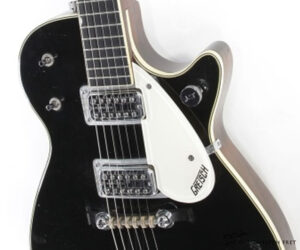When originally introduced in 1912, the Gibson L-4 appeared as a 16 inch wide, oval hole archtop, switching to F-holes in 1935. The cutaway body L-4C appeared in 1949 and by 1956 had displaced the non-cutaway model. In Gibson’s naming convention, the ‘C’ was dropped some years ago.
Ebony
Seen here is a new Sergei de Jonge Classical Guitar with an elevated fingerboard, pairing a Cedar top with Black Limba for the sides, back and neck. The bracing is Spruce, the body blocks and linings are Mahogany. The bridge is Indian Rosewood and the fingerboard is Ebony. As is the case for most of de Jonge’s guitars, the finish is a hand-applied French Polish.
Here’s a fantastic piece from early 1959, a Gretsch 6128 Duo Jet in Black Top finish. Just after this guitar was built, Gretsch altered the design to add a zero fret to the fingerboard. This is a great looking, playing and sounding guitar. It is one of the lightest electrics available at just over seven pounds (3.2kg), it plays well, and these Filter ‘Tron pickups are very good sounding. Introduced in 1954 just after the solid body, Pine capped 6130 Roundup, the chambered Duo Jet was aimed directly at Gibson’s Les Paul model, with a similar shape but very different yet hidden construction differences.
Here we’re looking at a Gibson Style A ‘Snakehead’ Black-top mandolin in A-1 trim from 1927 in overall good and largely original condition. The ‘Snakehead’ term refers to the tapered headstock, an innovation by Lloyd Loar that reduced string friction at the nut. ‘Snakehead’ models were built from 1923 to 1927.
This Sergei de Jonge Steel String Guitar pairs a Sitka Spruce top with Padauk for the sides, back, head plate, backstrap and rosette. Built during 2018 in Chelsea Quebec, it is in very good, clean condition, and delivers a full, rich and complex sound. Like many guitars from the de Jonge shops, this model has a French Polish finish, providing protection to the woods with a minimal imposition on the guitar’s vibration.
Shown here is an original condition Gibson SG Standard with optional Bigsby from 1973, in Walnut finish and originally sold at Mamelok LTD in Manchester, England, which closed in 1993. The Gibson SG Standard launched with the SG name in 1963, but really first appeared in 1961 as a radical redesign of the Les Paul model.






